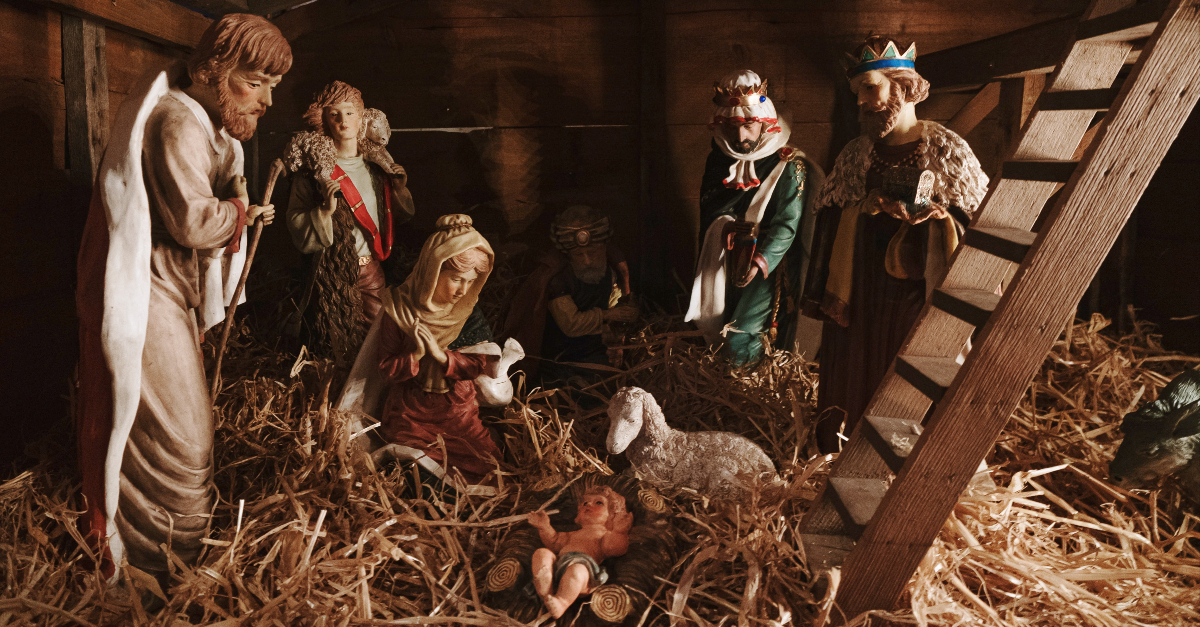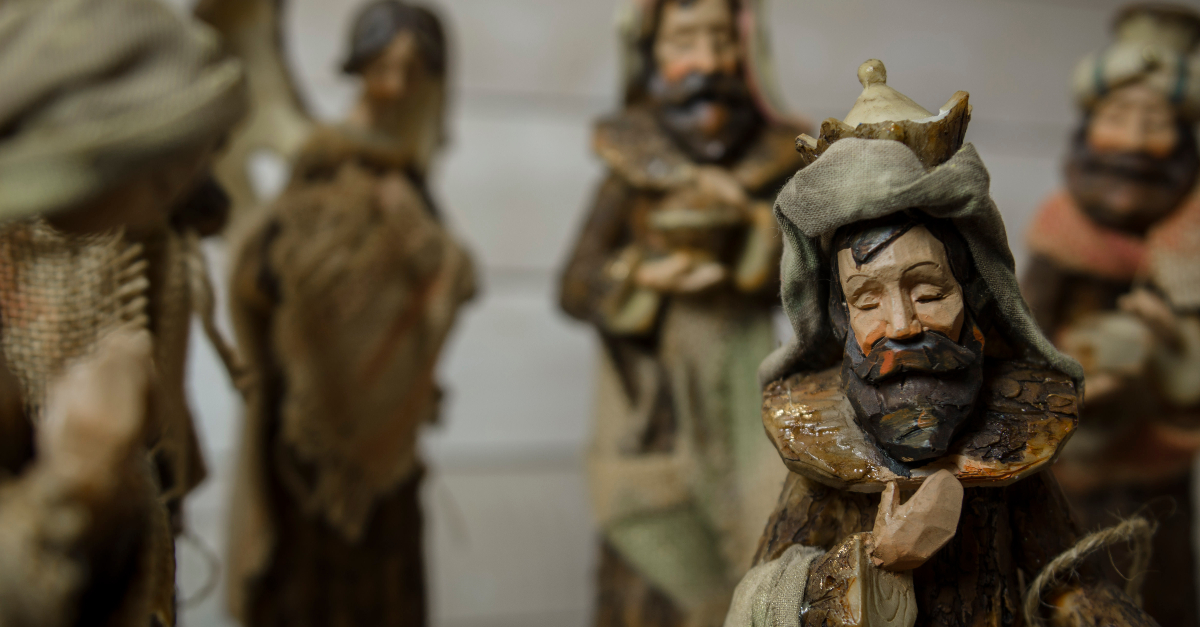Some Christians, especially those living in the United States, may be puzzled by the use of the word crèche. Indeed, some have never heard this word. Is there a more familiar term, and what does that term mean to the children of God today?
The Meaning of 'Creche'
Although the word crèche can mean a day-care facility or a crib, for Christians who use the word, it more likely represents a three-dimensional model or tableau of the supposed scene at the birth of Jesus—alternately called the “nativity scene.”
Most sources say the origin of the word is the French crèche in the late 1700s, or even earlier in Old French as cresche. Other sources point to the Old High German kripja or Old English cribb. Most people today who use the word creche drop the accent mark.
 Photo Credit: ©GettyImages/ChristianChan
Photo Credit: ©GettyImages/ChristianChan
Does It Matter if Christians Say Creche or Nativity?
Christians can and do use the terms interchangeably. But they need to understand neither word appears in the Word of God.
Technically creche refers to just the manger bed at Jesus’ birth, and the word used in Scripture accounts is “manger.” Over time, the word creche has lost its former meaning. It now refers to the entire nativity setting.
The word nativity is taken from the Latin nativus, which means “arisen by birth.”
Does 'Creche' Refer Specifically to Jesus’ Birth?
Again, “creche” does not appear in the Bible. But what was written in Scripture? And how did it refer to Jesus’ birth?
The biblical narratives regarding the birth of the Messiah are Matthew 1:18-25 and Luke 2:1-7. The Luke passage notes the manger: “and she gave birth to her firstborn, a son. She wrapped him in clothes and place him in a manger, because there was no guest room available for them” (v. 7, NIV).
The shepherds were told (Luke 2:12) their Messiah would be found “lying in a manger,” and they did find him there. Some sources say the word “manger” comes from the Latin word munducare, which means “to eat.” A manger–sometimes wood, but more often stone—held hay for larger animals. Mary likely did not want to place her newborn son on the hard, cold ground or floor, so a nearby manger provided a better alternative with its soft hay and raised sides to keep Jesus safe.
There may be some spiritual significance to this. As a feeding trough, animals found physical nourishment; but Jesus would forever nourish His followers spiritually as the Bread of Life (John 6:35; 51). How interesting that His birthplace, Bethlehem, means “House of Bread” in Hebrew.
Who Made the First Nativity Scenes?
According to Smithsonian Magazine, St. Francis of Assisi is credited with staging the first recorded Nativity scene in 1223 AD—although there were possibly earlier models. His biographer said the manger scene was set up in a cave in the Italian village of Grecio with real people and animals. Francis reportedly wanted to help children understand the true meaning of Christmas instead of focusing on gift-giving.
Portrayals of the Savior’s birth through these special scenes spread throughout Christendom, especially in Catholic churches; and Protestant churches, such as in Germany, soon created their own versions. In modern times, three of the most well-known Nativity scenes are at the White House in Washington, D.C., the Metropolitan Museum of Art in New York City, and the Vatican in Rome.
In a culture of bigger and better, Nativity scenes are not an exception. There are several Guinness World Records regarding nativities. The largest living nativity scene was created in 2019 in the Philippines, with 2,101 participants in the scene. The largest nativity scene figures were made by Sergio Rodriguez Villarreal in Mexico in 1999. Outdoing a Guinness World Record by a church in Florida, Pines Christian Church of Mt. Gilead, Ohio, gathered 2,300 unique nativity sets in 2015.
 Photo Credit: Unsplash/Alasdair Elmes
Photo Credit: Unsplash/Alasdair Elmes
How Did Nativity Sets Come into Our Homes?
Nativity displays are widely found in churches and public places during the Christmas season, but sets also found their place in Christian homes.
Early nativity sets were made from terracotta and displayed in Italian churches year-round. The sets began to appear in churches, and smaller sets also were purchased for the homes of wealthy Italian citizens. Craftsmen originally used wood and wax as well as terracotta, and they dressed the figures in beautiful clothes.
As nativity sets spread to Christian countries, they took on the unique styles of those countries, especially in Central American and Mediterranean countries. New traditions cropped up in various cultures. In Germany, for example, nativity scenes displayed all the figures before Christmas, but the figure of baby Jesus was only added after Christmas Eve.
Modern nativity sets are made of many different materials: ceramic, porcelain, resin, china, and various woods. In Israel, some sets are made of olive wood. The company Fontanini—founded by Italian artisan Emmanuele Fontanini in 1908—makes elaborate and always charming hand-painted sets. Collectors acquire many unique sets.
Should Christians Put Up a Nativity Scene?
Some critics of nativity scenes say they trivialize the birth of Jesus. Others suggest Christians should not display them, calling them a form of idolatry. Most Christians would argue they do not worship any part of the nativity scene, but only use the creche to remind themselves and others of the birth of Jesus and to celebrate His coming, not trivialize it.
Pastor Alistair Begg changed his mind about nativity scenes in recent years. He once was dismissive of them; but now, he says, “I’ve changed my views because our culture has changed. As society becomes increasingly secular, it seems to me that just about anything that ties Christmas back to the historical account of Jesus’s birth provides an important point of connection.” Such displays are an opportunity for engagement and conversation, he says.
“So,” Begg wrote, “when you see a nativity scene this Christmas, stop. Think. This really happened. God sent His Son. He really came. Of course, it didn’t look quite like it’s been portrayed, but it happened. And don’t forget to talk about it.”
In recent years, as companies cater to Christians’ desires to share the wonder of Christmas, large nativity scenes have popped up in many front yards. Christians sometimes use these colorful, brightly lit displays to share the Gospel with neighbors.
 Photo Credit: ©SparrowStock
Photo Credit: ©SparrowStock
Are Nativity Scenes Accurate?
When Christians take time to study the Gospel narratives, they will find some discrepancies with their own nativity sets. A basic set includes a stylized stable, Mary, Joseph, a manger, and baby Jesus. Sets may also add shepherds and sheep, the angel Gabriel, the star of Bethlehem, and various other barn animals. But Jonathan Merritt pointed out many inaccuracies in today’s nativity scenes from a biblical perspective.
The Bible says there was no room for Joseph and pregnant Mary “in the inn,” basically a guest room for visitors. We know Jesus was “born in a manger,” and nativity sets often show an elaborate stable or humble cave with a manger. But Jesus was probably more likely born in the lower level of a home where animals were often kept, protecting them from theft.
Beautiful angels are often part of a nativity set, but they aren’t mentioned at the site—though they may have been there. The Bible says angels came to the shepherds in the fields (Luke 2:8-14).
Cows and donkeys are part of some sets, but cows and donkeys are not mentioned in the canonical accounts. The donkey is often added because some suppose Mary rode one to Bethlehem, but they could have traveled in a caravan. It is assumed the shepherds had sheep, but they may not have brought them to the manger scene in their rush to see Jesus. Camels are often included with the addition of wise men, but the Scriptures do not say they rode camels. Again, there are no animals mentioned in the Gospel narratives.
Some sets include three “wise men,” usually decked out in regal robes and gold jewelry. The song, “We Three Kings” has perpetuated this concept, as well as the gifts they brought to Jesus. The Bible says they were “Magi from the east”—priestly wise men, sometimes described as astrologers, and probably from Persia. They followed an unusual star to visit the infant Jesus.
But the Gospels do not say there were three Magi. That is assumed because there were three gifts—frankincense, gold, and myrrh. It is only Christian tradition that gave the “three kings” their names: Melchior, Gaspar, and Balthasar. Also, the magi aren’t mentioned that first night. They came later, when Jesus was in a house (Matthew 2:11).
One fact about modern nativity scenes is a point of contention with many. During the Renaissance, the “holy family” looked more European, and since the mid-19th century in the United States, figures typically look Caucasian with white skin and blue eyes. The Bible does not tell us the color of Jesus’ skin. Though He was a multi-ethnic Jew with a bloodline from various races and cultural backgrounds, He and His earthly parents were of Middle Eastern Jewish descent, and likely had dark olive skin and Jewish traits.
A Simple Prayer As We Observe a Nativity Scene
Father God, Renew my wonder of the miracle of Your Son’s birth. May I say with the angels, “Glory to God in the highest heaven,” as I meditate on the miracle of His coming. Amen.
Photo Credit: ©Getty Images/kevron2001
 Dawn Wilson and her husband Bob live in Southern California. They have two married sons and three granddaughters. Dawn works part-time for Revive Our Hearts. She is the founder/director of Heart Choices Today, publishes Truth Talk with Dawn, and writes for Crosswalk.com. Her co-authored book is Truth Talk for Hurting Hearts: Discover Peace and Comfort Through God’s Perspective.
Dawn Wilson and her husband Bob live in Southern California. They have two married sons and three granddaughters. Dawn works part-time for Revive Our Hearts. She is the founder/director of Heart Choices Today, publishes Truth Talk with Dawn, and writes for Crosswalk.com. Her co-authored book is Truth Talk for Hurting Hearts: Discover Peace and Comfort Through God’s Perspective.
This article is part of our larger Christmas and Advent resource library centered around the events leading up to the birth of Jesus Christ. We hope these articles help you understand the meaning and story behind important Christian holidays and dates and encourage you as you take time to reflect on all that God has done for us through His Son, Jesus Christ!
What Is Christmas? It's History, Origin, and Traditions
The History and Origin of Santa Claus
Christmas Prayers and Blessings
The Beautiful Meaning and Purpose of Advent
Advent Prayers
Advent Wreath & Candles Meaning
The History and Meaning of the Advent Calendar